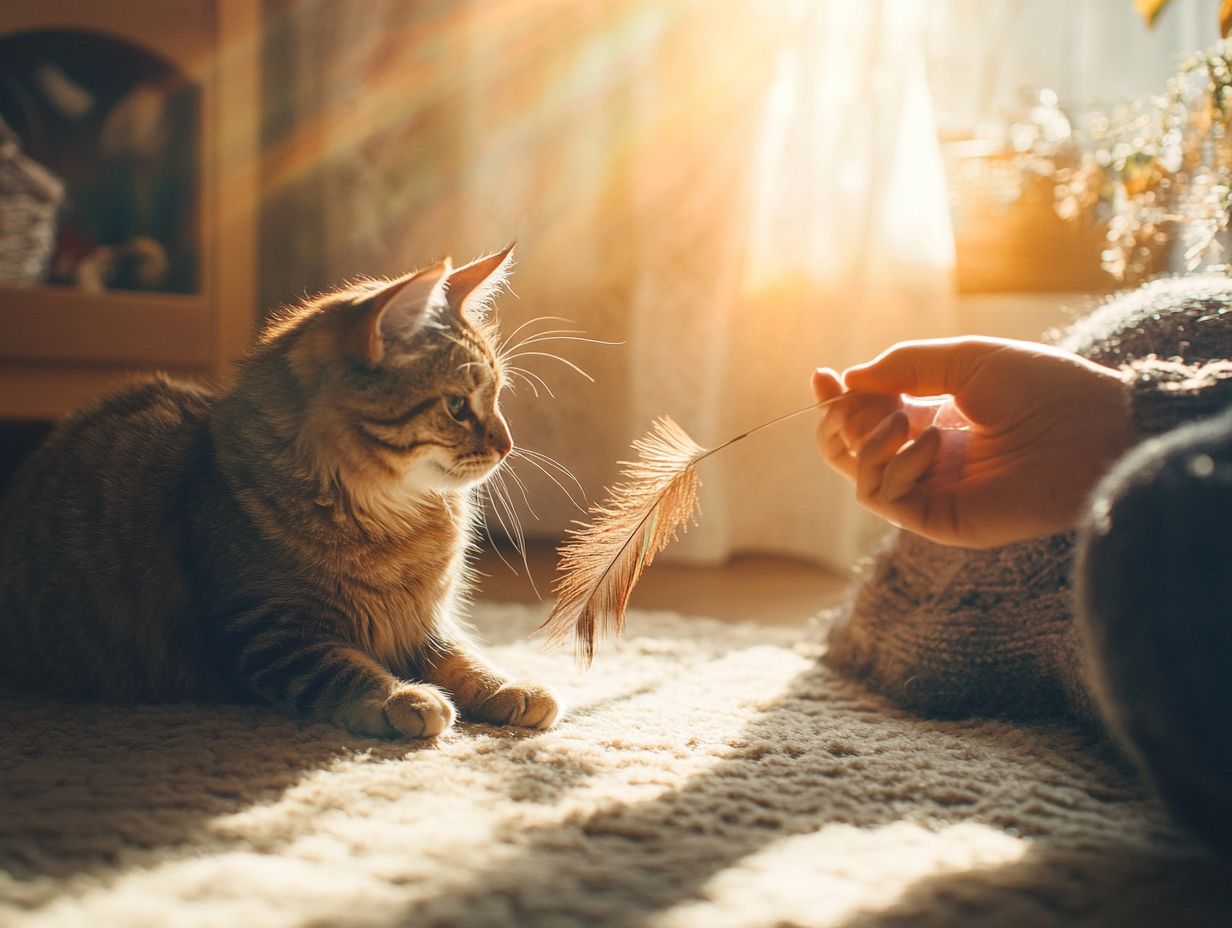Playtime is essential for cats, providing mental stimulation, physical exercise, and encouraging cat engagement, which contribute to their overall well-being. According to the American Association of Feline Practitioners, engaging in play is vital for maintaining a cat’s health.
From interactive games to solo activities involving cat toys and catnip, understanding the different types of play your feline friend enjoys can enhance your bond and keep them happy. Research indicates that play not only develops a cat’s physical skills but also enhances cognitive abilities.
This article explores the various forms of cat play, offers tips to encourage engagement, and shares fun games you can enjoy together, ensuring cat welfare and reducing behavior problems. Remember, play preferences can vary significantly as cats grow from kittens into adulthood and eventually into their senior years.
Dive in to discover how play can transform your cat’s life—and yours!
Key Takeaways:
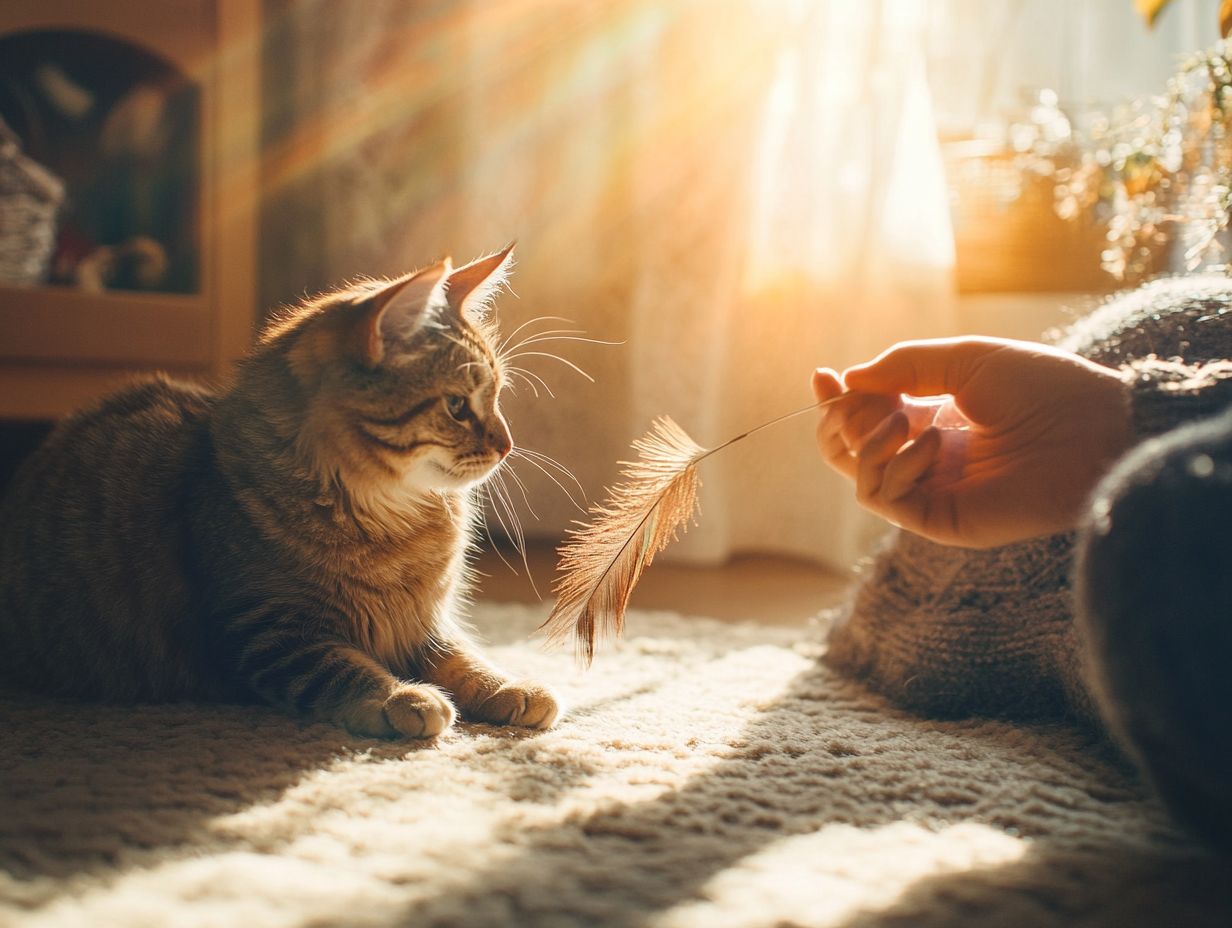
- Play is crucial for cats’ physical development and mental well-being.
- Cats enjoy interactive, solo, hunting, social play, and showing off their hunting instinct.
- Encourage play by choosing the right toys, creating a stimulating environment with cat trees and cardboard boxes, and incorporating it into daily routines.
Why is Play Important for Cats?
Play is an essential aspect of a cat’s life, significantly contributing to its physical development, mental stimulation, and overall well-being. Different forms of play enhance a cat’s hunting instincts and social skills, boost its confidence, and help prevent behavioral issues such as boredom. A lack of play can lead to stress and anxiety, affecting a cat’s overall health.
When owners recognize the importance of play, it leads to improved cat welfare and creates a more enriched environment that fosters healthy behavior in cats. Cats’ play preferences can change as they age; kittens may prefer more interactive play, while senior cats might enjoy gentler activities.
What Types of Play do Cats Enjoy?
Cats engage in various types of play, each serving different functions. These include social play, which helps build relationships; locomotor play, which provides physical exercise; object play, which hones hunting skills; and self-directed play, which encourages independent exploration. Understanding these types of play is essential for ensuring proper environmental enrichment and overall well-being for cats.
1. Interactive Play
Interactive play is crucial for cats, as it enhances their social communication and provides physical stimulation through engaging activities. Toys such as feathered wands or fishing rod toys strengthen the bond between cats and their owners, promote feline welfare, and help reduce behavioral issues. Owners should practice positive reinforcement during play sessions to encourage desirable behaviors.
To maximize the benefits of play, owners should pay attention to their pet’s preferences and adjust their interactions accordingly by offering a variety of toys and environments. Daily play sessions lasting at least 15 minutes can significantly improve a cat’s mood and overall well-being while fostering a strong bond between the human and feline companions. Consider incorporating environmental enrichment strategies, such as providing vertical spaces for climbing or sensory tools to stimulate exploration.
2. Solo Play
Solo play offers cats the opportunity to explore their environment and develop skills independently, allowing them to express instinctual behaviors in the absence of humans. Toys such as food puzzles or catnip-infused items provide mental stimulation, helping to reduce signs of boredom. To learn more about engaging your feline friend, check out this guide on How to Play With Your Cat.
Interactive toys like laser pointers or feather wands can engage a cat’s hunting instincts, making solo play an enjoyable experience for both the pet and the owner. These activities not only entertain cats but also provide essential physical exercise to promote a healthy weight.
Treat-dispensing balls are innovative products that offer hours of problem-solving fun and cognitive challenges, along with the reward of an occasional treat. By incorporating environmental enrichment, we ensure the well-being of cats, reduce behavioral problems, and contribute to happier pets.
3. Hunting Play
Hunting play mimics a cat’s natural instincts and behaviors, allowing them to practice crucial skills such as stalking and pouncing. Using toys that simulate prey, like pouncing toys and feather wands, can enhance a cat’s hunting abilities while providing both entertainment and excitement.
Common Play-Related Issues
Some cats may exhibit aggressive behaviors during play, which can stem from overstimulation or frustration. If you notice signs of discomfort or aggression, such as hissing or swatting, it’s essential to take a break and provide a calm environment. Gradual introductions of new toys can help mitigate these issues.
Understanding Individual Variation
Different breeds may have unique play preferences and behaviors. For instance, Siamese cats might enjoy more interactive play, while Scottish Folds may prefer gentle solo activities. Understanding your cat’s breed traits can guide you in selecting appropriate toys and activities.
Building the Human-Cat Bond
Play fosters a stronger bond between cats and their humans beyond just physical activity, including emotional aspects. Engaging playtime can help deepen your relationship and provide comfort during stressful times.
Myth Busting
Many misconceptions exist about play. For example, it is a myth that “cats don’t need to play after adulthood.” All cats, regardless of age, benefit from regular play to maintain their mental and physical health.
Positive Reinforcement and Ethical Considerations
When integrating play into training, always prioritize positive reinforcement, as punishment can lead to fear and anxiety. Choose toys that are safe and humane for your cat to ensure an enjoyable play experience.
Conclusion
Integrating play into daily routines is essential for a cat’s well-being. By recognizing individual preferences, offering a variety of engaging activities, and understanding the importance of play at different developmental stages, you will contribute to a happier and healthier feline companion. For further information on feline behavior and play, consider checking out reputable resources or consulting a veterinary behaviorist.
This type of play not only satisfies their innate desire to chase but also significantly contributes to their physical and mental well-being. Regular hunting play helps keep cats fit, reducing the risk of obesity while promoting muscle tone and agility. Studies from veterinary journals indicate that active play can lower stress and anxiety levels in cats, enhancing their emotional health.
Interactive toys, such as laser pointers or motion-activated devices, can also keep them mentally stimulated and curb destructive behaviors that stem from boredom. Offering a safe outlet for their predatory instincts helps improve their feline companions’ quality of life, resulting in happier and healthier pets.
4. Social Play
Social play is crucial for cats, particularly in multi-cat households, as it fosters interaction and communication between feline companions and their human caregivers. Engaging in play sessions together can significantly reduce behavioral issues and enhance the overall quality of the cat ownership experience.
Furthermore, social play promotes socialization, creating a more harmonious environment for cats and helping them develop essential social skills and interactions with one another. The likelihood of territorial disputes decreases when cats engage in play, as they learn to share resources and form friendly relationships. Additionally, the bond between cats and their owners strengthens through play activities, which build trust and alleviate anxiety.
To encourage social play in multi-cat homes, it is beneficial to:
- Rotate toys to maintain their interest
- Create designated play areas
- Incorporate interactive games that require collaborative play
Regularly scheduled playtime can transform the living environment into an engaging and stimulating space for both cats and their humans.
How to Encourage Your Cat to Play?
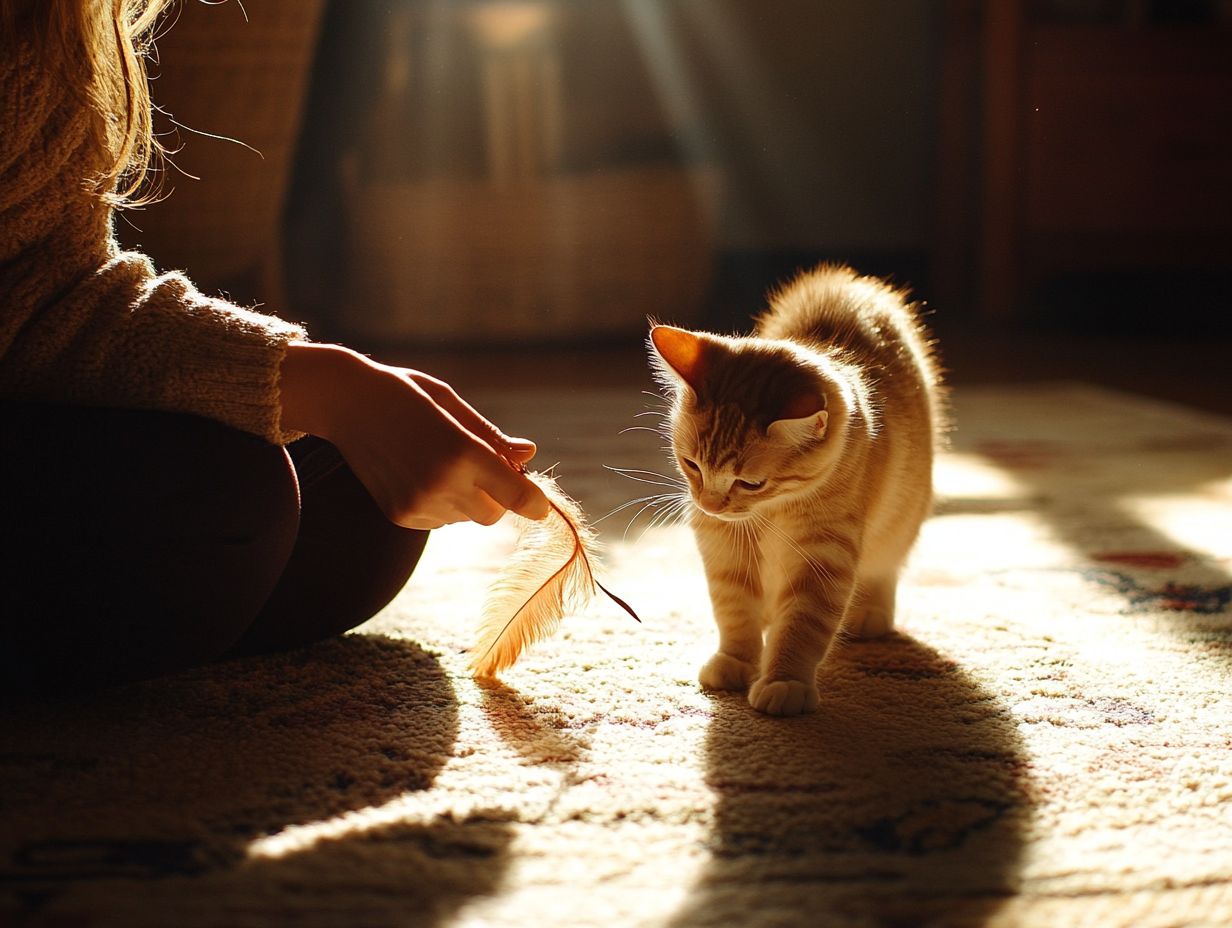
To encourage your cat to play, create a stimulating environment with suitable cat toys and incorporate regular playtime into their daily routine, utilizing short sessions. Consider integrating puzzle feeders and climbing structures to enrich their environment further.
By understanding your cat’s preferences and providing a safe space for exploration, owners can cultivate a happy and engaged atmosphere that promotes healthy behavior in their feline companions. Recognizing body language signals, such as a twitching tail or focused stare, can indicate a willingness to play.
1. Choose the Right Toys
The best toys for your cat are those that align with their individual play preferences, whether they include feathered toys, catnip, or food puzzles. Understanding your cat’s specific likes and dislikes is essential for selecting toys that will capture their attention and encourage active engagement during playtime. For example, some cats may be more stimulated by interactive toys that require owner involvement, while others may prefer solo toys.
Each feline has unique preferences that can significantly influence their toy choices, which is why it’s important to explore different categories such as interactive, solo, and hunting toys. Observing how your cat reacts to various types of toys will provide insight into their favorites. For instance, you might notice that they become more animated with a laser pointer but show little interest in a plush mouse.
Experimenting with different toys for short periods will help you narrow down your options and keep your furry friend happily engaged. Additionally, employing positive reinforcement during play can enhance trust and motivate your cat to engage more frequently.
2. Create a Safe and Stimulating Environment
Creating a safe and stimulating environment for a cat encourages play and exploration through the strategic placement of cat trees, interactive toys, and even simple items like cardboard boxes. Environmental enrichment fosters natural behaviors while providing a sense of security and comfort during playtime.
To further enhance the environment, consider adding cat shelves that promote climbing and exploration, along with various scratching posts that satisfy their natural instincts and help maintain their claws. A diverse selection of toys, such as feather wands, laser pointers, and puzzle feeders, can keep them engaged and mentally stimulated. It’s essential to recognize signs of discomfort or stress during play, ensuring a positive experience.
Additionally, incorporating soft bedding in cozy nooks offers a safe retreat for cats to unwind after an energetic play session. Together, these elements create a rich, instinct-driven environment that supports both physical and mental well-being.
3. Incorporate Play into Daily Routine
Integrating playtime into your cat’s daily routine not only benefits their physical health but also strengthens the bond between cat and owner. Regular interactions through play create a predictable environment, helping cats feel secure and understood.
Incorporating play into your cat’s daily routine is essential for providing regular mental and physical stimulation, both of which are crucial for their well-being. Research indicates that play not only reduces stress but also significantly improves a cat’s mental health (Source: Journal of Feline Medicine and Surgery). Scheduling short play sessions throughout the day can enhance engagement and strengthen the bond between cats and their owners.
By establishing a consistent schedule, such as morning and evening playtimes, you create a predictable environment where your cat feels secure and excited. Keep each session brief, around 10 to 15 minutes, to align with their natural attention spans while allowing plenty of time for rest in between.
Observing your pet’s energy levels can help you determine the best moments for play, whether during their most active periods or when they appear restless. Additionally, utilizing a variety of toys and activities can cater to their preferences and prevent boredom, making playtime a highlight of their day. Remember, different breeds may have unique play preferences, so consider your cat’s individual personality and energy level when planning activities.
How to Play with Your Cat?
Engaging in play with your cat can strengthen your bond and provide the necessary stimulation they need through various play methods. Understanding how to play with your cat is essential to ensure they get the most enjoyment and address their cat preferences out of playtime.
1. Use Interactive Toys
Interactive toys are essential for cats, as they provide the stimulation needed to encourage active participation during play. Examples of such toys include food puzzles, laser pointers, and those found in pet stores, all of which can heighten a cat’s excitement and engagement during playtime. Ensure that all toys are non-toxic and safe for your pets.
These interactive toys also facilitate interaction between cats and their owners, as well as with their surroundings. Feather wands and electronic mouse toys are additional options that capture feline interest, promoting both physical activity and mental engagement. By satisfying a cat’s natural hunting instincts, these toys can strengthen the bond between pet and owner through shared play experiences, promoting cat communication.
To optimize engagement during play, it’s important to rotate different types of toys to prevent monotony, while also allowing time for exploration and rest. Establishing a routine that incorporates consistent interactive play sessions alongside independent play can enrich a cat’s life significantly.
2. Engage in Chase and Pounce Games
Chase and pounce games harness a cat’s natural hunting instincts, offering both mental and physical stimulation and helping to develop cat training skills. By incorporating pouncing toys and engaging in interactive chase games, cat owners can enhance their pets’ communication skills while ensuring enjoyable playtime.
These activities not only entertain and promote physical activity but also play a crucial role in reducing boredom and preventing behavioral issues. Common behavioral problems associated with insufficient play include aggression and anxiety, which can be mitigated through regular, engaging play sessions. To maximize effectiveness, owners should provide a variety of toys, such as:
- feather wands
- laser pointers
- motorized mice
to keep their cats engaged and challenged. Additionally, alternating between fast-paced chases and slow, stealthy movements can create an unpredictable, hunting-like experience. Monitoring your cat’s body language—such as tail position and ear orientation—can help you gauge their enjoyment and prevent overstimulation.
Through these chase and pounce games, a cat’s natural instincts are satisfied, leading to improved welfare and a happier, more confident pet.
3. Encourage Your Cat to Hunt
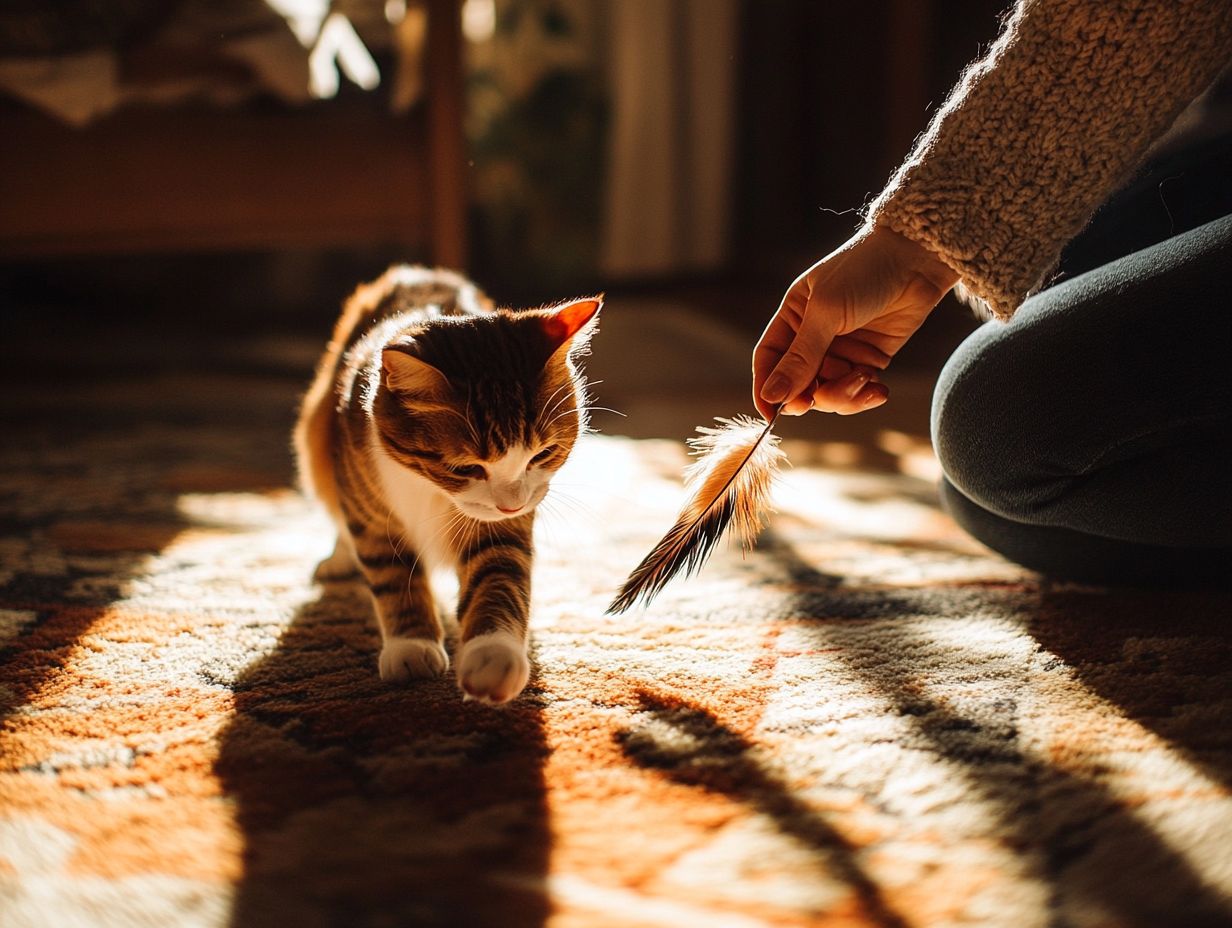
Teaching your cat to hunt through play enhances their interest and fulfillment while allowing them to exercise their natural instincts. Using toys that mimic the stalking behavior of prey provides an opportunity for them to practice their hunting skills and experience the thrill of the chase.
Interactive options, such as feather wands or laser pointers, allow owners to simulate the erratic movements of small animals, making the experience even more exciting. Additionally, playing hide-and-seek with toys that can be concealed further stimulates their problem-solving abilities and cat curiosity.
This form of engagement not only satisfies their natural hunting behavior but also alleviates boredom, minimizing the risk of destructive actions. Ultimately, these activities contribute to a cat’s mental well-being and promote a healthier, happier lifestyle.
4. Try Out Different Types of Play
It’s important to tailor play activities according to your cat’s age. Kittens may benefit from shorter, more energetic play sessions, while older cats often prefer gentle, slower-paced interactions. Establishing a play routine early in a cat’s life can prevent behavior problems later on.
For multi-cat households, managing play sessions can be essential to ensure all cats get sufficient engagement. Introducing toys that can be used collectively or scheduling individual playtimes can help reduce competition and aggression among pets.
Always remember to reward desired behaviors during playtime, perhaps by giving treats when a cat engages positively with a toy. This not only reinforces good behavior but also enhances the bonding experience.
In conclusion, play is not just an activity; it is an essential component of a cat’s overall health and well-being. Regular veterinary check-ups and consultations with animal behaviorists can ensure that play-related issues are addressed promptly, contributing to a fulfilling life for your feline friend.
Exploring various types of play can help reveal a cat’s individual preferences and enhance their overall engagement, contributing to cat enrichment. By rotating interactive games and using different toys, cat owners can ensure that playtime remains both enjoyable and constructive for their pets. Research from veterinary behaviorists emphasizes that a stimulating environment not only supports physical health but also alleviates stress and anxiety, promoting emotional well-being.
Engaging with diverse play options not only entertains a cat but also stimulates their instincts, promoting both physical activity and mental engagement. Different breeds may exhibit unique play preferences and energy levels, making it essential to tailor activities to suit each cat’s personality.
Choices such as feather wands, puzzle toys, and even DIY play stations can cater to different aspects of a cat’s playful personality. Introducing new textures and scents can further enrich their environment, create variety, and prevent cat boredom. It’s important to observe a cat’s body language during play to identify signs of enjoyment or overstimulation.
Observing how a cat interacts with these different play types allows owners to identify the activities that bring their pet the most joy. In cases of extreme reluctance to engage, consulting a veterinarian or animal behaviorist might be advisable.
What are Some Fun Games to Play with Your Cat?
Engaging in fun games with your cat not only stimulates their mind but also strengthens the bond between you and your pet. Activities such as laser pointer chases, hide and seek, and other interactive games promote both exercise, cat health, and mental engagement, ensuring that playtime remains enjoyable and interactive. Each game can foster trust and a deeper relationship through shared enjoyment.
1. Hide and Seek
Hide and seek is a game that boosts a cat’s excitement and engages them as they search for hidden toys or treats. This interactive activity is not only enjoyable but also enhances the bond between a cat and its owner. For kittens, this game may offer vigorous stimulation, while older cats might prefer gentler versions.
To start, choose a quiet room and allow your cat to settle in. Next, present a toy or treat that your cat enjoys, then place it in a hiding spot, such as behind a cushion or under a table. Call your pet’s name in an excited voice to encourage them to find it. You can also use a wand toy as a target or distraction to increase the challenge.
This game promotes physical activity while developing problem-solving skills and cat expressions, resulting in a happier and more mentally stimulated pet. To keep things interesting, consider changing hiding spots or varying the items, ensuring that both you and your pet enjoy this engaging and fun activity.
2. Laser Pointer Chase
Playing chase with your cat using a laser pointer is an excellent way to provide both physical stimulation and mental exercise, as cats love the challenge of trying to catch the elusive light, enhancing their cat excitement. This game mimics their natural hunting behavior, promoting movement and excitement, making it a favorite among many pet cats.
However, safety is crucial when using laser pointers; the beam should never be directed toward the eyes, as it can cause damage. To keep your cat engaged, vary the speed and direction of the light, and navigate it around obstacles. This approach not only maintains their interest but also mimics their natural hunting behavior.
Engaging in such activities helps your cat maintain a healthy weight and prevents boredom, significantly contributing to their overall well-being and energy levels. It is also important to reward your cat during these activities to promote positive associations.
3. Feather Wand Play
Feather wands are excellent for encouraging cats’ natural hunting instincts, as their movement mimics that of small prey, enticing pouncing and chasing behaviors. This interactive toy fosters engagement and offers a valuable opportunity for owners to connect with their cats.
By incorporating various techniques, such as quick flicks and smooth glides, the feather wand can keep felines engaged and stimulated. Varying the speed and direction simulates a real-life chase, promoting instinctual responses that enhance agility and reflexes.
These play sessions provide essential physical exercise, helping to counteract obesity and promote muscle development, while also offering mental enrichment that prevents boredom-related behaviors. Additionally, this type of play strengthens the emotional bond between owner and pet, contributing to a healthier, happier lifestyle for cats. Therefore, feather wands are an important addition to any cat owner’s toolkit.
4. Catnip Playtime
Catnip playtime can elicit joyful responses in cats by increasing their excitement and encouraging active play. Using catnip-infused toys during play sessions enhances stimulation and enjoyment for your pet. However, response to catnip varies by individual; some cats may show little interest.
Catnip, scientifically known as Nepeta cataria, is an herb that many cats adore, often triggering a playful response that showcases their natural hunting instincts. Offering catnip in a safe and controlled manner can enhance play and contribute to a cat’s well-being.
To maximize the effects of catnip, consider filling scratching posts, stuffed mice, and balls with it, or sprinkling it in areas where your cat tends to play the most, supporting cat activities. Studies have shown that catnip can significantly enhance feline activity levels (Journal of Feline Medicine and Surgery). An interactive approach, such as placing catnip in a puzzle toy for your cat to explore and solve, can help keep your cat engaged and invigorated.
Additionally, rotating toys can provide novelty and maintain excitement during playtime, allowing your cat to enjoy the benefits of catnip while participating in fun activities. Remember, observing your cat’s preferences is crucial for effective play.
Frequently Asked Questions
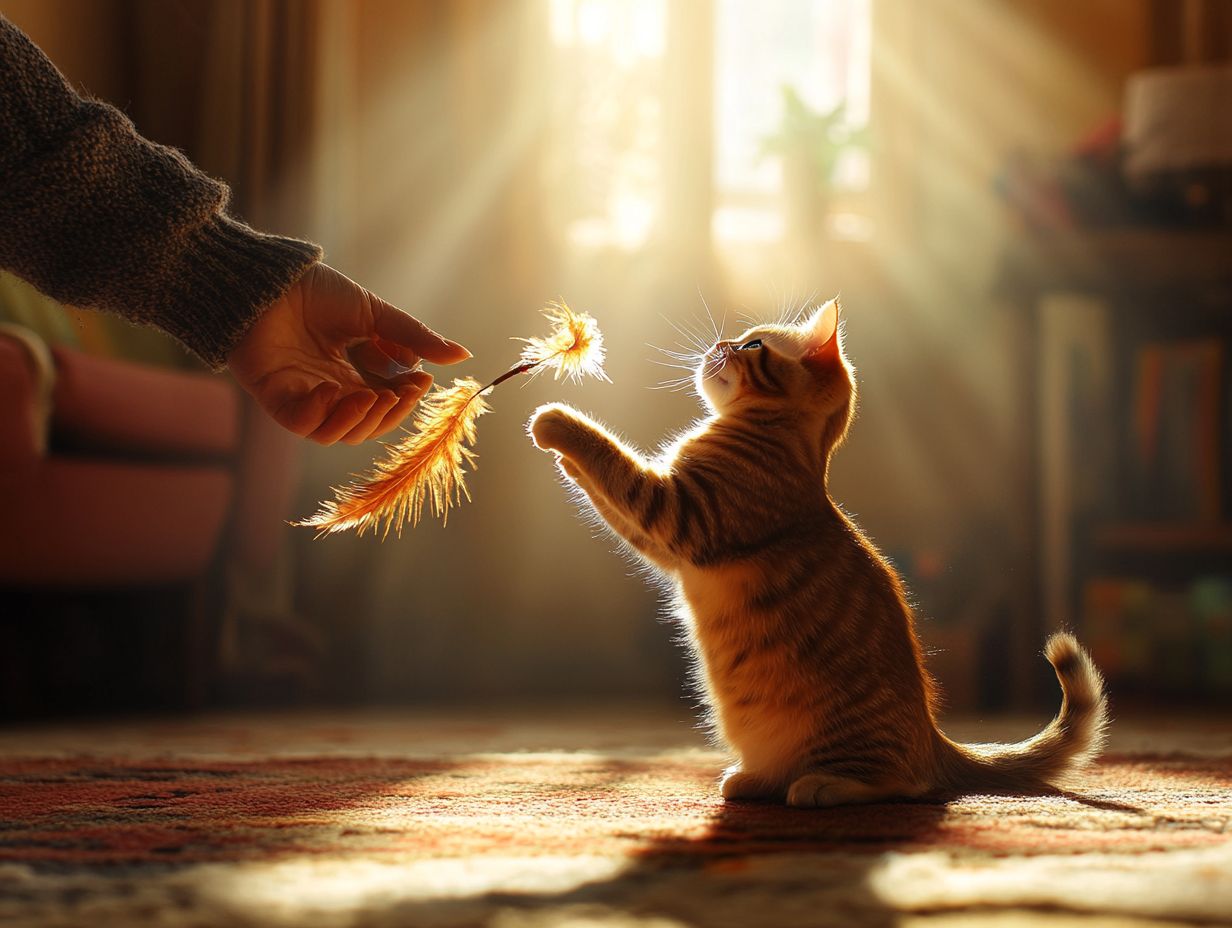
What are some fun ways to play with my cat?
1. Use interactive toys such as feather wands or laser pointers to engage your cat in play.
2. Create a DIY obstacle course using pillows, boxes, or tunnels for your cat to explore.
3. Play hide and seek by hiding treats or toys around the house for your cat to find.
4. Use a catnip-filled toy or sprinkle catnip on a scratching post to encourage play.
5. Engage in pretend hunting games by dragging a toy on a string and allowing your cat to pounce and “catch” it.
6. Set up a window perch for your cat to watch birds and other outdoor activities.
Is it important to vary the types of play I do with my cat?
Yes, varying play types is crucial to keep your cat mentally stimulated, prevent cat boredom, and cater to their natural instincts. Different breeds may exhibit varying play preferences, so it’s important to observe individual behaviors to tailor activities accordingly.
How can I tell if my cat is enjoying our playtime?
Signs that your cat is enjoying playtime include dilated pupils, crouching in a pouncing position, and swishing their tail back and forth. Vocalizations like meowing or chirping can also indicate excitement. Understanding your cat’s body language is key to ensuring a positive play experience.
Is it better to engage in cat interaction during certain times of the day?
Cats tend to be more active during dawn and dusk, so engaging in interactions during these times may yield better results. Aligning playtime with their natural rhythms mimics their instinctive behaviors. Pay attention to your cat’s preferences to identify their optimal playtimes.
Are there any toys or objects that are not safe for my cat in terms of cat safety?
Yes, it’s important to carefully select toys and objects for your cat to play with to ensure their safety. Avoid toys with small parts that could be swallowed, sharp edges, or potential choking hazards. Household items like string, rubber bands, and plastic bags can also be dangerous if ingested. Consider using toys like Da Bird or Hexbug, designed with safety in mind.
Can I use my hands to play with my cat, or should I focus on play techniques?
It’s generally not recommended to use your hands as toys when playing with your cat. This can encourage biting or scratching and blur the lines between play and aggression. Utilize designated toys like a Cat Dancer to promote safe play. Additionally, using cat treats can reinforce positive behaviors.
How can I recognize signs of stress during play?
Signs of stress can include tail flicking, sudden withdrawal, or excessive grooming. Be mindful of these cues and consider taking breaks or employing calming techniques. Early intervention is critical if you notice any changes in your cat’s play behavior, as it may indicate stress, boredom, or health concerns.
What common myths about cat play should I be aware of?
Many believe that cats are solitary animals, but they actually benefit from interactive play that fulfills their social needs. Engaging in play not only provides physical stimulation but also promotes emotional well-being.
How does play relate to my cat’s overall health?
Regular play is essential for maintaining your cat’s physical health, helping with weight management, improving mental stimulation, and fostering emotional well-being. Any drastic changes in behavior should prompt a consultation with your veterinarian.
Where can I learn more about feline behavior and enrichment?
For those interested in understanding feline behavior more deeply, consider accessing resources like veterinary behaviorists or reputable studies on cat play and enrichment. Continuous education is vital for enhancing your cat’s quality of life.
